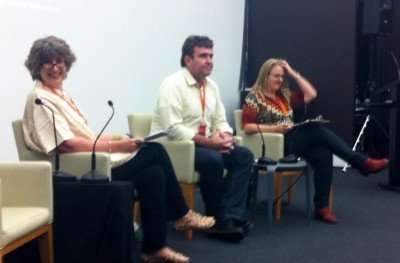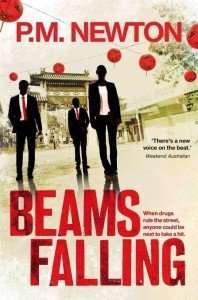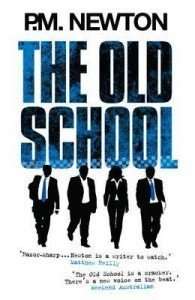P M Newton at the Brisbane Writers Festival
I was lucky enough to attend four author discussion sessions at the 2014 Brisbane Writers Festival.
 I’ve already published an article on the first of those sessions which featured Mark Mulholland & Brigid Delaney.
I’ve already published an article on the first of those sessions which featured Mark Mulholland & Brigid Delaney.
I share my take-outs from the session featuring P M Newton below. Session write-ups still to come will feature authors Lenny Bartulin, Michael Robotham and Yrsa Sigurdardottir and Clare Wright.
CAUSE OF DEATH: Crime Writer P.M Newton and Bond Universities Wayne Petherick team with Meg Vann to investigate the gritty scientific and legal foundations of crime stories.
Saturday 6th September
P.M. Newton (Pam) joined the New South Wales police force in 1982. She spent the next thirteen years working in and around Sydney in various departments – Drug Enforcement, Sexual Assault, Major Crime – first in uniform, then as a detective. When she had eventually had enough of meeting people for the first time on the worst day of their lives, Newton resigned from the Job to travel and live overseas. She now lives in Sydney. Her first novel, The Old School, won the Sisters in Crime Davitt Award and the Asher Literary Award, and was shortlisted for the Indie Award for Debut Fiction and the Ned Kelly Award for Best First Fiction. Her latest novel Beams Falling was also shortlisted for the Ned Kelly Award.
Wayne Petherick is Associate Professor of Criminology at Bond University on the Gold Coast, Queensland, Australia. Wayne is President of the Academy of Behavioral Profiling and assistant journal editor for the Journal of Behavioral Profiling. He teaches in the areas of criminal profiling, behavioural evidence analysis, criminal motivations, case studies in forensic science, and crime and deviance. Wayne has consulted on many cases for state law enforcement and the private sector on stalking, sexual assault, and homicide. He has lectured at the Australian Federal Police Academy in Canberra and to state law enforcement groups in Australia and the United States.
Meg Vann has trekked over glaciers with her toddler while pregnant, talked herself out of being mugged on the streets of New York, and been detained for no apparent reason at Uzbekistan airport while on a diplomatic visa. In between her travels, Meg is also Chief Executive Officer, Queensland Writers Centre, Convenor of Sisters in Crime (Brisbane Chapter) and writing tutor and guest lecturer. Meg’s first publication ‘Provocation’, a 10,000 word psychological thriller, is out in The Review of Australian Fiction.
Are the boundaries of real and fictional criminal investigation being blurred?
Unanimous agreement – people who think real criminal investigations are like the CSI shows on TV are sadly mistaken. In the real world investigations are much slower paced, test results do not come back as quickly and often not all evidence that might aid a case is actually collected and catalogued. Why? Competing priorities for finite resources and people are human.
Wayne said that because of what they witness on TV shows juries have come to expect physical evidence, and 70% of US jurors want DNA evidence. Often it’s just not available.
Pam spoke about her experiences in the NSW police force and how she did not feel the need to go and view the bodies at crash sites etc, she left that up to the forensic people and the crime scene photographer. She knew of people not lasting very long in those roles – looking at that day-in and day-out can be highly traumatic.
The dead are dead in a way that no one can act, there is an absence.
Both Pam and Wayne raised the terrible lack of privacy of the deceased, how as soon as someone is murdered their personal lives are trawled through.
Meg perceptively asked Wayne to explain his observation that “the victim and offender are often the same person”. A startling proportion (something like 80%+) of victims precipitate their own demise, e.g. years of abuse/harrassment, threats. There is actually a term ‘spoiled memory syndrome’ referring to when murder investigations yield information about a victim’s life not known to their family and friends and how this is difficult for the grieving to reconcile.
Police are dealing with the facts in front of them – rarely do they have the time to delve too far back into the history and psychology of the crime. As popular as it is on TV shows, Wayne explained that in reality criminal profiling is rarely necessary as more often than not offenders are already known to police. What is often required to successfully convict perpetrators though is the historical context of events and that’s where applied crime analysis comes to the fore. Often it is the victim’s family helping collate the historical information for their legal representatives.

-
P M Newton, Wayne Petherick and Meg Vann
Disclosure: If you click a link in this post we may earn a small commission to help offset our running costs.
Sign up to our Booklover Book Reviews emails and receive our gift for new subscribers. LEARN MORE >>
Does Pam draw on her police experience for technical aspects of her crime writing?
Her answer – not really. In her writing she likes to focus on characters and the human impact of crime. She advised aspiring crime writers to not worry about how plausible a particular blood spatter pattern on a wall is. Don’t worry about the forensic details.
You don’t need experience in a criminal field. We’re all an expert on human relationships.
For Pam the setting is a very important character. Where people come from and their experiences influence their current behaviour and attitudes. For instance she set Beams Falling in Cabramatta which in the 1980s was a hot bed of tensions stemming from the experiences of the largely migrant and Vietnam War refugee population and their offspring now reaching adulthood.
She cited what she believes is an example of TV crime done well, Broadchurch, reasoning that when someone is murdered finding who killed them does not magically make everything alright again. The damage to those that knew the victim or were in some way involved are lasting. While she understands some readers may seek an ending tied up in a bow she rebels against providing that in her novels. That’s not what crime is about.
Dispelling the myths
Spoiler alert. You know the crime fiction trope of the obsessed detective – it rarely happens in reality. Both Pam and Wayne agree that kind of behaviour is simply unsustainable in a long term career. If you did that you wouldn’t last long. And you need to remember that members of the law enforcement need to live in the same (sometimes small) communities they police.
Does the ‘hand in your badge and gun’ and then investigate from the sidelines scenario happen? No.
How easy is it to frame someone for a crime? It’s very difficult these days given everything is recorded and so many people are involved in any one investigation. But, something termed ‘noble cause corruption’ may still occur in situations where officers know a person is guilty but are having difficulty proving it – they may attempt to plant evidence to bolster the brief.
Do ‘Moriarties’ or criminal masterminds exist? No such thing according to Wayne. Rarely do you see a crime scene wiped clean like in the TV shows. They are typically very messy situations and often those first on the scene will encounter the perpetrator standing next to the victim with the weapon in plain sight, something that was in easy reach at the moment they ‘snapped’. And that’s what it ultimately comes down to. Most perpetrators of crime are known to their victims and the events that lead to murder are often very ordinary, involving domestic disputes, drugs and/or alcohol. It’s rarely one event, but a series of repeated behaviours over time, and one of those straws breaks the camel’s back.
A fascinating and informative discussion. High praise to Meg Vann for ensuring levity and good humour reigned in a session that (thanks to Pam and Wayne’s candor) at times included very graphic descriptions of violent acts and crime scenes.

 On the inside, Detective Nhu ‘Ned’ Kelly is a mess. Stitched up after being shot, her brain’s taking even longer to heal than her body. On the outside, though, she’s perfect, at least as far as the top brass are concerned. Cabramatta is riding high on the new ‘Asian crime wave’, a nightmare of heroin, home invasions, and hits of all kinds, and the cops need a way into the world of teenaged dealers and assassins.
On the inside, Detective Nhu ‘Ned’ Kelly is a mess. Stitched up after being shot, her brain’s taking even longer to heal than her body. On the outside, though, she’s perfect, at least as far as the top brass are concerned. Cabramatta is riding high on the new ‘Asian crime wave’, a nightmare of heroin, home invasions, and hits of all kinds, and the cops need a way into the world of teenaged dealers and assassins. ‘Two things you want to remember about the good old days, Ned. They weren’t that good and they’re not that old.’
‘Two things you want to remember about the good old days, Ned. They weren’t that good and they’re not that old.’